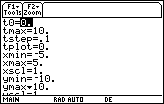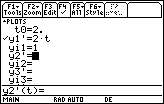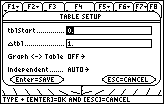Solutions to differential equations are found graphically and numerically in this lesson. Slope fields and particular solutions are also discussed.
The TI-89 has a graphing mode that allows you to find graphical and numerical solutions to differential equations. This mode is called the Differential Equation graphing mode.
Solve y' = 2x graphically.
-
Open the Mode dialog box by pressing

-
Open the Graph submenu by pressing

- Highlight "6:DIFF EQUATIONS"

-
Select and save this mode setting by pressing
 twice
twice
|
|||
|
|
|||
- Enter the equation y1' = 2·t into the Y= Editor

- Select the window values shown below


|
|||||||||||
|
|
|||||||||||
-
The graph that results from pressing

 is called a slope-field.
is called a slope-field.

Slope Fields
The slope field contains short line segments with slope 2x at selected points in the window. This particular window uses 98 points arranged in 7 rows and 14 columns. The line segments could be thought of as linear approximations, or tangent lines, of particular solutions through the points.
Notice that all the line segments in a given column are parallel because they all have the same x-coordinate and therefore the same slope, 2x.
Finding a Particular Solution
Find the particular solution to the differential equation
- Display the Y= Editor
- y1' should be 2·t
-
Move the cursor to "t0=" and enter 2
This is the initial value of t, i.e., x. -
Move the cursor to "yi1="
This is the value of y1 for the initial value t0: y1(t0) = yi1. - Enter 1

-
Press

 and set Fields to SLPFLD.
and set Fields to SLPFLD.
-
Display the graph of the particular solution by pressing



The slope field is shown and the particular solution when y(2) = 1 is indicated by the darker connected curve.
-
Trace along the particular solution by pressing

The coordinates of t, x, and y will be displayed at the bottom of the screen.
18.4.1 Use the Trace feature to find y(3) for this particular solution.
Click here for the answer.
Creating a Table of Values
You can use the TI-89 Table feature to create a table of values for the particular solution to y' = 2x and y(2) = 1. The table will display a numerical representation of the solution to the initial-value problem.
-
Open the Table Setup dialog box by pressing
 [TblSet]
[TblSet]
-
Set the values in dialog box so that tblStart = 0 and
 tbl = 1
tbl = 1

-
Save these values by pressing

-
Display the table by pressing
 [TABLE]
[TABLE]

Each pair of values t and y1 represents a point (x, y) of the particular solution. Notice that the initial condition y(2) = 1 is shown and that y(3) = 6 is also there. You can display points on smaller intervals by adjusting
![]() tbl in the TblSet dialog box.
tbl in the TblSet dialog box.
18.4.2 Graph the slope field and the solution for the initial-value problem y' = e–x2 and y(-3) = 0.01. Use a [-3, 3] x [-0.5, 2] window. Remember to use t in place of x in the Y = Editor.
Click here for the answer.
The Slope Field of y' = y
The slope field for the differential equation y' = y is significantly different from those previously shown. The solution of y' = y represents a function where the slope of the tangent at each point (x, y) is the y-coordinate of that point. The slope of solutions to y' = y is a function of y rather than x. How do you think this will affect the slope field?
18.4.3 Sketch a rough approximation of the slope field for y' = y. Compare your slope field with the slope field given by your TI-89. What is the major difference between the slope field for this problem and the previously illustrated slope fields?
Click here for the answer.